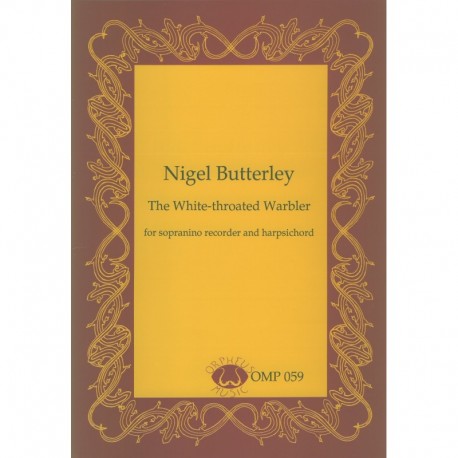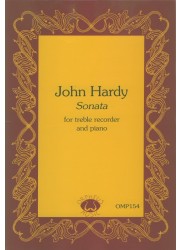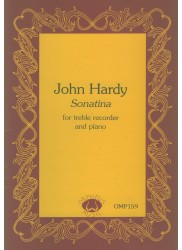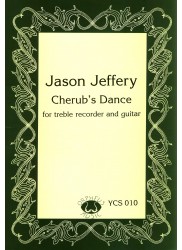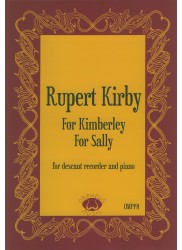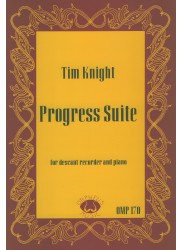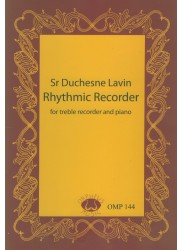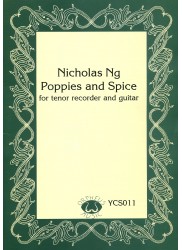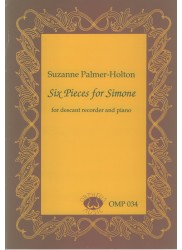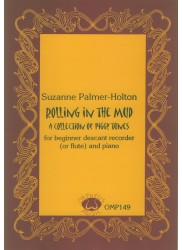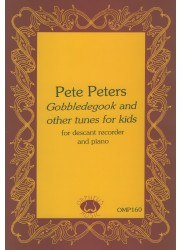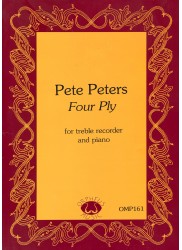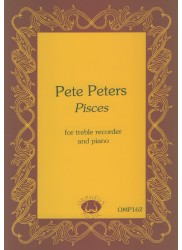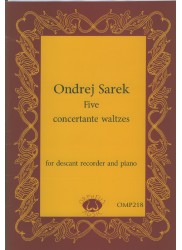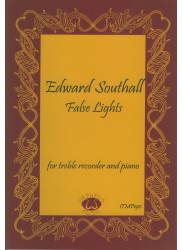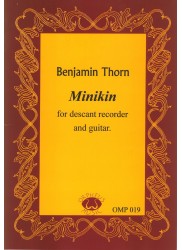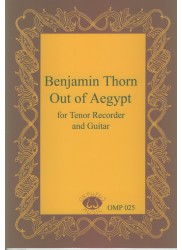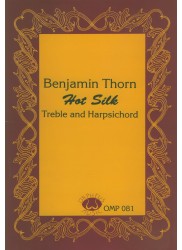No products
Prices are tax included
The White-Throated Warbler
Composer: Butterley - Nigel
Instrumentation: Sopranino + Harpsichord
Period/genre: Australian Contemporary
Grade: Difficult
More info
*Contemporary Piece.* Classic short piece that evokes birdsong.
1. The White-Throated Warbler
_AMEB Grade 7 Treble List D_
_Score 2 pp. Part 1 pp._
OMP059 Nigel Butterley, The White-throated Warbler
OMP054 Benjamin Thorn, Pipistrelli Gialli
These new editions from Orpheus present two of the most important - some might even say classic - works in the history of modern Australian recorder music. Nigel Butterley's miniature The White-throated Warbler was written for Carl Dolmetsch back in 1965. The composer was inspired to create it when he heard Dolmetsch perform Couperin's Le Rossignol en Amour and was also influenced by the sound of a bird in his garden. It is described in the edition as a 12-tone work but Butterley's use of this method is not strict. Its trills, aperiodic rhythms, and repeated patterns, as well as its setting for the sopranino, are certainly evocative of birdsong, but its dissonant atonal language, very slow tempo, and sparse textures give a rather frozen, austere impression of a bird.
The White-throated Warbler was recorded in the 1970s by both Carl Dolmetsch and David Munrow. As a result of these recordings, it became the face of modern Australian recorder music to the world-at-large. This changed in the early 1990s when Benjamin Thorn's powerful bass composition The Voice of the Crocodile was published by Edition Moeck.
If Crocodile is Thorn's greatest piece, Pipistrelli gialli (Yellow Bats), written in 1985, is certainly his second greatest. Although in retrospect Thorn may not really have broken much new ground (what he did with live electronics is primitive compared to Michael Barker's experiments of the same period), he nevertheless created a powerful and memorable work that still sounds exciting and fresh today. In fact, the technology for which Pipistrelli was originally written - analog reel-to-reel tape delay - is completely outmoded. But the requirements can easily be met with modern digital equipment.
In the September 1993 issue of AR, I profiled Pipistrelli gialli in "On the Cutting Edge," describing it in detail after examining the manuscript and hearing a private tape recording of a performance by Mr Thorn. Since that issue of the magazine might not be readily available to most readers and especially since the written score rarely reflects the actual sound of the music (because of the electronic delay), I feel it appropriate to quote my earlier writing on the subject as follows:
"The first movement begins with a few widely spaced chattering sounds that quickly develop into a barrage of noises of ever-increasing intensity. More pronounced wilder calls emerge out of the general confusion, these also increasing in frequency and character from sustained multiphonics to screeches and screams. Quite dramatically, the music suddenly stops and a brief, purely acoustic interlude - quite shocking in its simplicity ? is heard. The wild confusion returns in moderation as all dies down to nothing.
"In the second movement we are given a simple ternary form, consisting of electronic collages, of multiphonics at the beginning and end and a quiet acoustical monophonic solo in the middle. The third movement is arc-like, featuring ghostly wails at the beginning and end, with a midsection that alternates wild electronic jumbles of sound with intense acoustic solos."
The most important development in Australian recorder music since the emergence of Benjamin Thorn as a Major talent has been the establishment of Orpheus Music. Like many small and regionally-oriented publishers that came into being in the 1990s, Orpheus has flooded the market, and its record of quality control has not been consistent. But with these particular editions, Orpheus has made a valuable contribution by offering two excellent compositions that are also historically important. Both editions are beautifully printed and contain no bad page turns. Warbler has a brief biographical note on the composer, and Pipistelli has a single page of suitable and to-the-point instructions. Both works will be of interest primarily to professionals.
Pete Rose, American Recorder, March 2003
OMP059 Nigel Butterley The White-Throated Warbler
The White-Throated Warbler was written during Carl (mistakenly printed as "Arnold" in the preface) Dolmetsch's 1965 tour of Australia and is yet another example of the finely-crafted compositions which have emanated from the antipodes. And, as with so many other works in the repertoire, it takes its inspiration from birdsong. The work is relatively short, lasting just over a minute, set to a slow tempo and makes use of serial compositional techniques, although the tone row used is not strict.
Compacted into the small framework of The White-Throated Warbler are a wealth of musical devices including trills (the wavy sign for the one in bar 2 is far too long), quintuplets and septuplets. This is all admirably supported above an equally evocative harpsichord accompaniment where the trills, tremolos and arpeggiated chords add to the ornithological nature of the piece greatly.
This is a valuable addition to the repertoire for sopranino recorder, and its much overdue re-publication is highly appropriate in light of recent research into the music commissioned by, or written for, Carl Dolmetsch.
Adam J. Dopadlik, The Recorder Magazine, Winter 2001
30 other products in the same category:
Reference: OMP154
Brand: Orpheus Music
Sonata
Composer: Hardy - John Instrumentation: Treble + Piano Period/genre:...
In StockReference: OMP154.pdf
Brand: Orpheus Music
Sonata
PLEASE NOTE - DOWNLOADABLE PDF VERSION Composer: Hardy - John...
$23.50 -20%In StockReference: OMP159
Brand: Orpheus Music
Sonatina
Composer: Hardy - John Instrumentation: Treble + Piano Period/genre:...
In StockReference: OMP159.pdf
Brand: Orpheus Music
Sonatina
PLEASE NOTE - DOWNLOADABLE PDF VERSION Composer: Hardy - John...
$19.00 -20%In StockReference: YCS010
Brand: Orpheus Music
Cherub's Dance
Composer: Jeffery - Jason Instrumentation: Treble + Guitar Period/genre:...
In StockReference: YCS010.pdf
Brand: Orpheus Music
Cherub's Dance
PLEASE NOTE - DOWNLOADABLE PDF VERSION Composer: Jeffery - Jason...
$16.00 -20%In StockReference: OMP184
Brand: Orpheus Music
Eleanor
Composer: Kirby - Rupert Instrumentation: Descant + Piano Period/genre:...
In StockReference: OMP184.pdf
Brand: Orpheus Music
Eleanor
PLEASE NOTE - DOWNLOADABLE PDF VERSION Composer: Kirby - Rupert...
$14.50 -20%In StockReference: OMP191
Brand: Orpheus Music
For Kimberley and For Sally
Composer: Kirby - Rupert Instrumentation: Descant + Piano Period/genre:...
In StockReference: OMP191.pdf
Brand: Orpheus Music
For Kimberley and For Sally
PLEASE NOTE - DOWNLOADABLE PDF VERSION Composer: Kirby - Rupert...
$16.00 -20%In StockReference: OMP170
Brand: Orpheus Music
Progress Suite
Composer: Knight - Tim Instrumentation: Descant + Piano Period/genre:...
In StockReference: OMP170.pdf
Brand: Orpheus Music
Progress Suite
PLEASE NOTE - DOWNLOADABLE PDF VERSION Composer: Knight - Tim...
$16.00 -20%In StockReference: OMP144.pdf
Brand: Orpheus Music
Rhythmic Recorder
PLEASE NOTE - DOWNLOADABLE PDF VERSION Composer: Lavin - Sr Duchesne...
$17.50 -20%In StockReference: YCS011
Brand: Orpheus Music
Poppies and Spice
Composer: Ng - Nicholas Instrumentation: Tenor + Guitar Period/genre:...
In StockReference: OMP034
Brand: Orpheus Music
Six Pieces for Simone
Composer: Palmer-Holton - Suzanne Instrumentation: Descant + Piano...
In StockReference: OMP149
Brand: Orpheus Music
Rolling in the Mud
Composer: Palmer-Holton - Suzanne Instrumentation: Descant + Piano...
In StockReference: OMP034.pdf
Brand: Orpheus Music
Six Pieces for Simone
PLEASE NOTE - DOWNLOADABLE PDF VERSION Composer: Palmer-Holton - Suzanne...
$14.50 -20%In StockReference: OMP160
Brand: Orpheus Music
Gobbledegook and other tunes for kids
Composer: Peters - Pete Instrumentation: Descant + Piano Period/genre:...
In StockReference: OMP161
Brand: Orpheus Music
Four Ply
Composer: Peters - Pete Instrumentation: Treble + Piano Period/genre:...
In StockReference: OMP162
Brand: Orpheus Music
Pisces
Composer: Peters - Pete Instrumentation: Treble + Piano Period/genre:...
In StockReference: OMP218
Brand: Orpheus Music
Five Concertante Waltzes
Composer: Sarek - Ondrej Instrumentation: Descant + Piano Period/genre:...
In StockReference: OMP218.pdf
Brand: Orpheus Music
Five Concertante Waltzes
PLEASE NOTE - DOWNLOADABLE PDF VERSION Composer: Sarek - Ondrej...
$20.50 -20%In StockReference: OMP190
Brand: Orpheus Music
False Lights
Composer: Southall - Edward Instrumentation: Treble + Piano Period/genre:...
In StockReference: OMP190.pdf
Brand: Orpheus Music
False Lights
PLEASE NOTE - DOWNLOADABLE PDF VERSION Composer: Southall - Edward...
$16.00 -20%In StockReference: OMP019
Brand: Orpheus Music
Minikin
Composer: Thorn - Benjamin Instrumentation: Descant + Guitar Period/genre:...
In StockReference: OMP019.pdf
Brand: Orpheus Music
Minikin
PLEASE NOTE - DOWNLOADABLE PDF VERSION Composer: Thorn - Benjamin...
$14.50 -20%In StockReference: OMP025
Brand: Orpheus Music
Out of Aegypt
Composer: Thorn - Benjamin Instrumentation: Treble/Tenor + Guitar...
In StockReference: OMP025.pdf
Brand: Orpheus Music
Out of Aegypt
PLEASE NOTE - DOWNLOADABLE PDF VERSION Composer: Thorn - Benjamin...
$16.00 -20%In StockReference: OMP081
Brand: Orpheus Music
Hot Silk
Composer: Thorn - Benjamin Instrumentation: Treble + Harpsichord...
In StockReference: OMP081.pdf
Brand: Orpheus Music
Hot Silk
PLEASE NOTE - DOWNLOADABLE PDF VERSION Composer: Thorn - Benjamin...
$17.50 -20%In Stock

